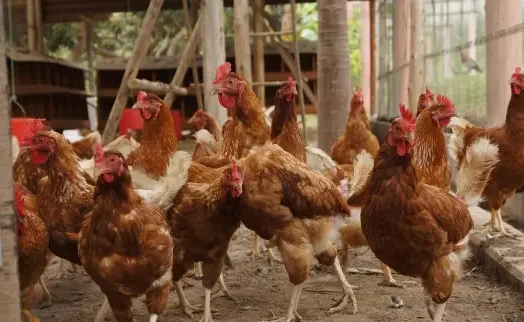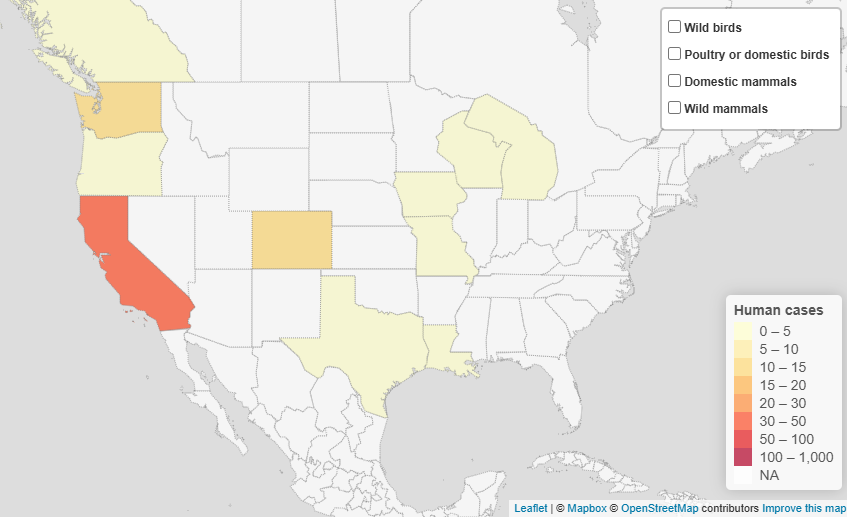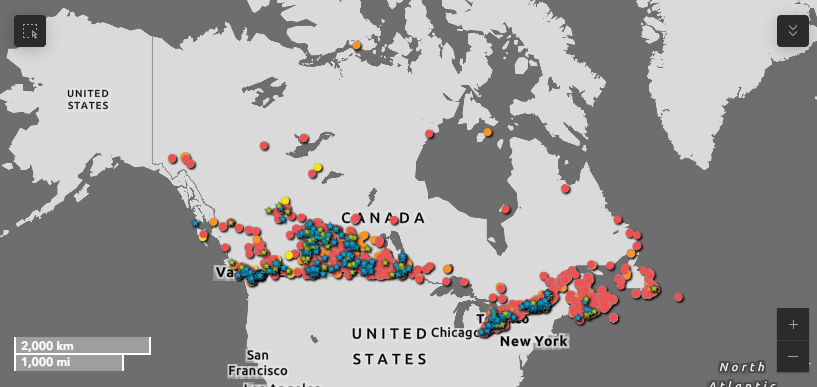About H5N1


Hunters and Bird Flu
Bird flu is a disease caused by avian influenza A viruses that usually spread between birds, not people. While the current public health risk is low for H5 bird flu, it has caused sporadic human infections, mostly in people who had contact with infected birds or dairy cows.
Wild birds can be infected and show no signs of illness. They can carry disease to new areas when migrating, potentially exposing domestic poultry to the virus. If you hunt or have other recreational exposure(s) to wild birds or other animals, there are actions you can take to protect yourself against bird flu.


Dear Friend Who is Worried About H5N1...
Guiness Pig 12 Feb 2025
Dear friend who is worried about H5N1,
You’re certainly not alone. I’m worried about H5N1 too. By now you’ve probably heard about it on the news or in your social media feed. You’ve seen videos of cow carcasses piled by the side of the road and birds flailing around on the ground, so ill they cannot even stand. You’ve seen the price of eggs skyrocket in a short period of time. If it seems like the situation is worsening, it is.
But no authority is going to tell you that. Under new directives from the federal government, all public communications from CDC, NIH, and other health authorities are paused.
Meanwhile we’re in the throes of the worst flu season on record for humans since the H1N1 Swine Flu pandemic in 2009. It doesn’t necessarily mean H5N1 is causing the increase in flu activity this year, but with all the different strains of influenza floating around right now, the chances for a reassortment event are high. Many of our trusted experts on the matter have assured us there’s no evidence that H5N1 is spreading human-to-human yet. With a historically observed mortality rate between 50-60%, we’ll know when it does.
It’s not a matter of if, but when.

Questions and Answers About H5N1 Influenza
Influenza: A(H5N1) 16 May 2024 | Q&A
- What is A(H5N1)?
- How does the H5N1 virus spread to people?
- Why is there concern about influenza H5N1 virus?
- What are the symptoms of H5N1 infection in humans?
- Is it safe to eat eggs, chicken and other meats and milk from areas with H5N1 outbreaks in animals?
- How can meat and eggs be safely prepared from areas with H5N1 outbreaks in birds?
- Is it safe to drink milk and other dairy products from areas where animals are infected with H5N1 viruses?
- How is H5N1 virus infection in humans treated?
- Is a vaccine available to prevent human infection with H5N1 viruses?
- Does seasonal influenza (seasonal flu) vaccination provide protection against human infection with H5N1 viruses?
- What does WHO do to respond to H5N1 influenza?

Influenza A(H5N1) in Americas Region
Distribution of Influenza A(H5N1) human cases by subnational level. As of 23 December 2024

Notes:
¹The sources for human cases include information provided by International Health Regulations (IHR) National Focal Points (NFPs) or extracted from publicly available official sources and compiled by PAHO/WHO. Please note that the data is subject to change.
²Source for animal data: World Organization for Animal Health (WOAH, founded as OIE) database: World Animal Health Information System (WAHIS) https://wahis.woah.org/#/home. Data extracted by Pan American Health Organization. Reproduced with permission. WOAH bears no responsibility for the integrity or accuracy of the data contained herein, but not limited to, any deletion, manipulation, or reformatting of data that may have occurred beyond its control.
³If the symptom onset date is not available, the report date to IHR Regional Contact Point or the date of collection will be used as a reference.
The data on the dashboard is refreshed weekly until 17:00 GMT-5 on Tuesday.


This Canadian dashboard tracks and automatically updates positive Avian Influenza cases that are both suspect and confirmed. It also breaks down positives by province. If you live in Canada, this is a site you may want to bookmark and return to.

Avian influenza A(H5N1): Symptoms and treatment
Current situation
Federal, provincial and territorial authorities are currently responding to a widespread outbreak of A(H5N1) across Canada. We’re monitoring detections in humans and animals globally, including recent cases associated with dairy cattle in the U.S. The risk of avian influenza infection to people in Canada remains low. Learn more:
Avian influenza is a contagious viral infection that mainly affects birds but can sometimes infect humans and other mammals. There are many types of avian influenza, which are all caused by various strains of type A influenza virus (e.g., H5N1, H7N3, H9N2). Avian influenza A(H5N1) illness is caused by the avian influenza A(H5N1) virus.

Guidance on human health issues related to avian influenza in Canada (HHAI)
Exposure sources:
There is relatively limited public health experience with avian influenza (AI) outbreaks and variability has been observed in the epidemiology of these outbreaks caused by different strains. Therefore, it may be necessary to modify the list of exposure sources of AI virus as the outbreak progresses, more information becomes available, or the situation changes (e.g., if there is evidence of airborne spread of the virus from an avian source or other infected animal[s]).
Potential exposure sources include:
- infected poultry (commercial or small/backyard flocks)
- infected wild birds
- infected captive or pet birds
- other infected domestic or wild animals (such as livestock (e.g., cattle, pigs, goats), cats, foxes, raccoons, skunks, mustelids (e.g., ferrets, mink), marine mammals (e.g., seals, sea lions),
- manure and litter of birds and other infected animals (can contain a high concentration of viruses)
- surfaces contaminated by bird or other infected animals’ dander/body fluids or body parts (e.g., carcasses, internal organs)
- not following safe handling practices when coming into contact with raw or undercooked products/parts from infected birds/animals, including meat, eggs and unpasteurized milk or milk products, or consuming these products/parts raw or undercooked (note that to date, there have been no confirmed human cases of avian influenza acquired through the consumption of food)
- contaminated vehicles, equipment, clothing and footwear used at involved sites (e.g., infected animal farms)
- contaminated air space (e.g., a barn when movement of birds/other infected animals or their litter/manure may have resulted in aerosolization of the virus)
- unprotected exposure to biological material (e.g., primary clinical specimens, virus culture isolates) known to contain AI virus in a laboratory setting
- individuals known to be infected with an AI virusFootnotea
Note: For outbreak control purposes, a flock, a site (e.g., farm), or an individual who is ill with a history of exposure to an avian/animal source of virus, might be considered a “potential source of AI virus” on epidemiological grounds in the absence of confirmed infection.

Avian influenza A(H5N1): For health professionals
Current situation
Federal, provincial and territorial authorities are currently responding to a widespread outbreak of A(H5N1) across Canada. We’re monitoring detections in humans and animals globally, including recent detections associated with dairy cattle in the U.S. The risk of avian influenza infection to people in Canada remains low. Learn more:
- Latest bird flu situation
- Travel health notice: Avian influenza
- Risk assessments for public health professionals
- Protocol for enhanced human surveillance of avian influenza A(H5N1) on farms in Canada
Key information
Outbreaks of avian influenza A(H5N1) in domestic and wild birds and some mammals have recently emerged and become widespread in Europe and North America, including across Canada, Central and South America, sub-Antarctic regions and Antarctica. Government authorities in Canada are currently responding to the outbreak of influenza A(H5N1) in farmed birds and wildlife across Canada.
Influenza A(H5N1) is a subtype of avian influenza virus that mainly infects birds, but has been identified in other animals and has caused rare and sporadic infections in humans.
Human cases of influenza A(H5N1) have primarily occurred due to zoonotic transmission through direct contact with infected birds (dead or alive) or contaminated environments. Human-to-human transmission is rare and there has been no evidence of sustained transmission between humans.
The virus mainly affects the respiratory tract but can also cause gastrointestinal or central nervous system manifestations. Infection may progress to severe illness and can be fatal.

Protocol for enhanced human surveillance of avian influenza A(H5N1) on farms in Canada
About this protocol
The Protocol for enhanced human surveillance of avian influenza A(H5N1) on farms in Canada has been designed as a proactive tool to support local public health authorities in the event of human infection or in unusual exposure scenarios on Canadian farms with infected livestock. This tool is intended to be used for a limited period of time and is not intended as routine practice. This protocol complements the Public health management of human cases of avian influenza and associated human contacts (AI CCM) and the Guidance on human health issues related to avian influenza in Canada (HHAI).
Provinces, territories (PTs), and local public health units can opt to use this protocol to enhance knowledge on A(H5N1) risk and transmission in Canada and to inform response.


Influenza (Avian and other zoonotic)
Key facts
- Humans can be infected with avian, swine and other influenza viruses.
- Direct contact with infected animals (through handling, culling, slaughtering or processing) or indirect contact (through environments contaminated with bodily fluids from infected animals) represent a risk for human infection.
- Exposure to animal influenza viruses can lead to infection and disease in humans – ranging from mild, flu-like symptoms or eye inflammation to severe, acute respiratory disease and/or death. Disease severity will depend upon the virus causing the infection and the characteristics of the infected individual.
- Currently circulating zoonotic influenza viruses have not yet demonstrated sustained person-to-person transmission.
- As influenza viruses have a natural reservoir in aquatic birds they are impossible to eradicate. Zoonotic influenza infections will continue to occur. To minimize public health risk, quality surveillance in both animal and human populations, thorough investigation of every human infection, and risk-based pandemic planning are essential.

H5 Bird Flu: Current Situation
December 24, 2024
What to know
- H5 bird flu is widespread in wild birds worldwide and is causing outbreaks in poultry and U.S. dairy cows with several recent human cases in U.S. dairy and poultry workers.
- While the current public health risk is low, CDC is watching the situation carefully and working with states to monitor people with animal exposures.
- CDC is using its flu surveillance systems to monitor for H5 bird flu activity in people.
Current situation
H5 Bird Flu Detections in USA
• Dairy cattle: Ongoing multi-state outbreak
• Wild Birds: Widespread
• Poultry Flocks: Sporadic outbreaks
• Mammals: Sporadic infections
• Person-to-person spread: None
• Current public health risk: Low

Signs and Symptoms of Bird Flu in People
December 20, 2024
Key points
- Most human cases of bird flu, caused by avian influenza A(H5) virus, in the United States have been mild, so far, and most were in people who had known exposure to sick or infected animals.
- The severity of illness associated with bird flu has ranged from mild to severe, including death.
- The reported signs and symptoms of bird flu in humans have varied. Eye redness has been the predominant symptom among recent U.S. cases of avian influenza A(H5) virus infection. Respiratory symptoms and fever were also reported.
- The possibility of human infections with avian influenza virus that result in severe illness remains and underscores the importance of ongoing prevention and surveillance efforts.

Highly Pathogenic Avian Influenza A(H5N1) Virus: Interim Recommendations for Prevention, Monitoring, and Public Health Investigations
What to know
This guidance outlines CDC’s recommendations for preventing human exposures to highly pathogenic avian influenza (HPAI) A(H5N1) viruses and infection prevention and control measures, including the use of personal protective equipment, testing, antiviral treatment, patient investigations, monitoring of exposed persons, and antiviral chemoprophylaxis of exposed persons.
Summary
The purpose of this guidance is to outline CDC’s recommendations for preventing exposures to highly pathogenic avian influenza (HPAI) A(H5N1) viruses, infection prevention and control measures including the use of personal protective equipment, testing, antiviral treatment, patient investigations, monitoring of exposed persons (including persons exposed to sick or dead wild and domesticated animals and livestock with suspected or confirmed infection with highly pathogenic avian influenza (HPAI) A(H5N1) virus), and antiviral chemoprophylaxis of exposed persons. These recommendations are based on available information and will be updated as needed when new information becomes available.

Cats can get sick with bird flu. Here's how to protect them
The death of an Oregon house cat and a pet food recall are raising questions about the ongoing outbreak of bird flu and how people can protect their pets.
Bird flu has been spreading for years in wild birds, chickens, turkeys and many other animals. It was first confirmed in U.S. dairy cattle in March.
The virus has been causing sporadic, mostly mild illnesses in people in the U.S., and nearly all of those infected worked on dairy or poultry farms. When the virus is found, every bird on a farm is killed to limit the spread of the disease.
Oregon health officials traced the cat’s illness to frozen cat food that contained raw turkey. Virus recovered from the recalled pet food and the infected cat matched.


Is Bird Flu a Risk to Humans?
The first severe case of illness caused by bird flu has been reported in the U.S.
A southwestern Louisiana patient is the first person in the U.S. to have a severe case of bird flu (H5N1 avian influenza), health officials have confirmed. The patient, who is over the age of 65 and is reported to have underlying medical conditions, is experiencing severe respiratory illness and is currently hospitalized in critical condition, a spokesperson for the Louisiana Department of Health told AARP. Flu can be especially serious in older adults, who are at higher risk for developing complications in part due to changes in the immune system that happen with age, the Centers for Disease Control and Prevention (CDC) says.


National Pandemic Strategy
The following pandemic strategy documents and resources are intended to guide the United States’ preparedness and response during an influenza (flu) pandemic.
In 1997, avian influenza A(H5N1) viruses first spread from poultry to humans in Hong Kong. Of the 18 persons infected with the virus, 6 died. Concerned that this A(H5N1) virus could easily spread to and between people, the World Health Organization (WHO) and United States government increased pandemic preparedness. An influenza pandemic could place an extraordinary burden on health care systems and essential community services. Preparing for such a threat is an important priority.
